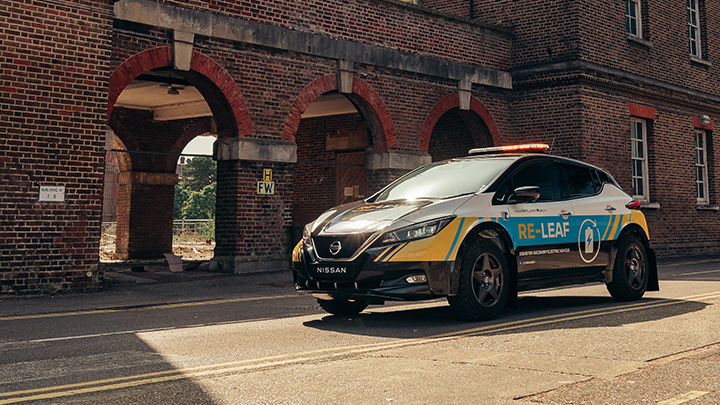Nissan unveils its 100% electric emergency response vehicle concept, the Nissan RE-LEAF. It is designed to provide a mobile power supply during natural disasters or extreme weather conditions.
The Nissan RE-LEAF is based on the Nissan LEAF passenger car, the world’s first mass-production electric car. With modifications made to navigate through roads covered in debris, the RE-LEAF features weatherproof plug sockets mounted directly to the exterior of the vehicle, allowing 110- to 230-volt devices to be powered from the car’s high-capacity lithium-ion battery. This makes it possible to provide a zero-emission mobile emergency power supply that can run medical, communications, lighting, heating, and other life-supporting equipment.
“We’re constantly exploring ways that electric vehicles can enrich our lives, beyond just zero-emission transportation,” said Helen Perry, head of electric passenger cars and infrastructure for Nissan in Europe. “Concepts like the RE-LEAF show the possible application of EVs in disaster management and demonstrate that smarter, cleaner technology can help save lives and provide greater resilience.”
According to Nissan, the concept vehicle can provide power to an average European household in six days. This is made possible with the RE-LEAF’s 62-kilowatt-hour LEAF e+ battery. It can also travel up to 385 km on a single charge.
The Nissan RE-LEAF can also be a mobile storage batteries that supply electricity to homes during non-emergency situations through Nissan Energy Share. It uses the LEAF’s bidirectional charging ability, a standard feature of the model since its introduction in 2010. This means that the LEAF can pull power to recharge the high-capacity battery and push it back to the grid through V2G (Vehicle-to-
Grid) technology, or directly to electric devices through V2X (Vehicle-to-everything).
With the technology of Electric Vehicles, the possibility of saving more lives during times of emergencies and natural disasters increase. With power outages, it usually takes 24 to 48 hours, depending on the severity, before they are restored. These units can power multiple devices simultaneously for 24 hours such as an electric jackhammer, pressure ventilation, a 10-liter soup kettle for 24 hours, an intensive care medical ventilator, and a 100-watt LED floodlight.




